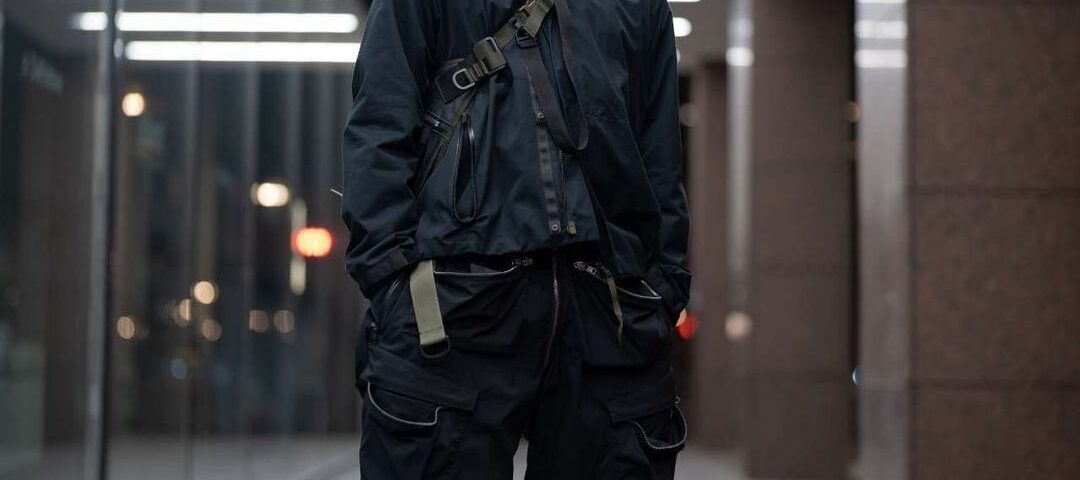
Essential Techwear Pieces to Complete Your Dystopia Style Look
May 3, 2025
Why Techwear Is the Backbone of Modern Dystopia Style Aesthetics
May 3, 2025Introduction
In recent years, techwear has surged in popularity as a fashion movement that blurs the line between urban survival gear and futuristic streetwear. With aesthetics often drawn from dystopian fiction and cyberpunk culture, techwear is more than a style—it’s a statement. Central to this style’s authenticity and functionality is the use of advanced materials. These high-performance fabrics are what give techwear its reputation for durability, weather resistance, and modular versatility.
In this article, we’ll explore how dystopian aesthetics converge with high-tech function, and dive deep into the techwear materials that drive this hybrid evolution in modern fashion.
What Is Techwear?
Techwear, short for “technical wear,” refers to a style of clothing that emphasizes utility, function, and advanced performance materials. Popular among urban dwellers, digital nomads, and cyberpunk enthusiasts, techwear offers:
-
Waterproofing & Weather Resistance
-
Durability and Longevity
-
Comfort and Mobility
-
Storage & Modular Components
-
Stealthy, Futuristic Aesthetics
While the appearance is often dark, tactical, and post-apocalyptic, the underlying theme is preparedness—mirroring the survivalist spirit of dystopian fiction.
The Intersection of Dystopia and Fashion
The dystopian style is defined by minimalism, tactical design, muted colors (primarily blacks and greys), and utilitarian function. Inspired by worlds in crisis—such as seen in Blade Runner, The Matrix, or Ghost in the Shell—this fashion aesthetic reflects a future where resources are scarce, society is fragmented, and survival depends on adaptability.
This philosophy makes techwear a natural fit for dystopian fashion. But what truly fuels its effectiveness are the materials used. Let’s examine them.
The Core Techwear Materials
1. GORE-TEX®: The Gold Standard of Weatherproofing
GORE-TEX is perhaps the most recognizable name in high-performance apparel. It is a multi-layer membrane that offers:
-
Waterproofing
-
Breathability
-
Windproof Protection
This makes it ideal for jackets, outer shells, and footwear. In the dystopian wardrobe, where surviving in harsh weather is a theme, GORE-TEX® gives techwear its authenticity and real-world viability.
2. Dyneema®: Ultra-Light and Stronger Than Steel
Dubbed “the world’s strongest fiber,” Dyneema is a high-strength polyethylene that offers:
-
Abrasion resistance
-
Lightweight performance
-
Tear and cut resistance
Often used in body armor, sails, and climbing gear, Dyneema makes techwear incredibly durable while keeping the outfit lightweight—perfect for tactical vests, pouches, and outer shells.
3. Ripstop Nylon and Cordura®
These are rugged, synthetic fabrics used in military and adventure gear. Key features include:
-
Anti-tear weave patterns
-
Lightweight but tough
-
Water and dirt repellence
For techwear pants, cargo pockets, and weather-ready jackets, these materials provide structure without compromising flexibility.
4. Softshell and Hardshell Fabrics
Softshells are used for comfort and mild weather resistance, while hardshells are designed for severe weather conditions. These fabrics are often layered in techwear to provide:
-
Temperature control
-
Wind protection
-
Layering versatility
This reflects the modular, survivalist ethos of dystopian design.
5. Neoprene
A synthetic rubber used in wetsuits, neoprene is making its way into techwear due to:
-
Stretch and flexibility
-
Thermal insulation
-
Water resistance
It adds a sleek, tactical look to garments and is used in hoods, gloves, and fitted tops.
Key Performance Features of Techwear Materials
Beyond the names of the fabrics, it’s essential to understand the performance metrics that define true techwear.
a. Water Resistance and Waterproofing
True techwear is designed to combat the elements. Waterproof materials like GORE-TEX® and laminated nylon repel water while allowing vapor to escape—essential for maintaining dryness without overheating.
b. Breathability
Breathability is crucial in high-performance garments. Without it, the wearer would quickly overheat or accumulate sweat. Mesh linings, underarm vents, and moisture-wicking fabrics are commonly integrated.
c. Durability
Durability is a non-negotiable trait. These clothes are meant to endure rough urban landscapes, weather conditions, and long-term use. Reinforced seams, ripstop weaves, and ballistic fabrics deliver resilience.
d. Stretch and Mobility
Techwear integrates 4-way stretch fabrics like elastane blends to enable full range of motion—ideal for commuting, parkour, or travel in unpredictable terrain.
e. Lightweight Functionality
One of the most attractive features of modern techwear is the lightweight feel despite rugged performance. Materials like Dyneema and ultra-light nylon fulfill the goal of minimalist efficiency.
Aesthetic Influence: How Materials Shape Style
In dystopian techwear, the fabric is as much about visual storytelling as function. Here’s how material choices shape the look:
-
Matte textures (e.g., softshells, Cordura) create a stealthy, urban ninja vibe.
-
Reflective or iridescent finishes add futuristic, cyberpunk flair.
-
Bonded seams and taped zippers reduce bulk and support a clean, tactical look.
-
Layering modular garments (vests, chest rigs, detachable sleeves) reinforces the apocalyptic survivalist feel.
Techwear doesn’t shout—it whispers preparedness. Every pocket, strap, and zipper is there for a reason.
Sustainable Techwear Materials: The Future of Dystopian Fashion?
As environmental concerns grow, the techwear movement is shifting toward sustainability without sacrificing function. Innovations include:
-
Recycled Nylon and Polyester: Brands are now repurposing plastic bottles into waterproof shells.
-
Eco-Friendly Coatings: Fluorocarbon-free DWR (Durable Water Repellent) finishes are replacing toxic waterproofing treatments.
-
Biodegradable Fabrics: Some startups are developing natural fiber-based techwear alternatives with wax coatings and barrier membranes.
These changes reflect a new kind of dystopia—one focused not just on surviving the future, but sustaining it.
Brands Pioneering Techwear Material Innovation
Several fashion brands and designers are leading the charge in combining techwear materials with urban dystopian aesthetics:
-
ACRONYM: Founded by Errolson Hugh, ACRONYM is legendary for fusing avant-garde design with tactical performance. Their garments use GORE-TEX®, Schoeller®, and advanced modular elements.
-
Veilance (by Arc’teryx): Sleek, minimal, and laser-focused on materials like GORE-TEX Pro® and advanced shell fabrics.
-
Nike ACG & Stone Island Shadow Project: Mainstream fashion meets performance with weather-ready outerwear and experimental fabric blends.
-
Guerrilla-Group, Y-3, and Riot Division: Brands merging East Asian cyberpunk style with military-grade materials.
These labels understand that in a world that feels increasingly unstable, form and function must coexist.
Techwear Material Care and Maintenance Tips
To keep your dystopian wardrobe functional and long-lasting:
-
Avoid regular detergents—they can strip water-repellent coatings.
-
Use techwear-specific cleaners like Granger’s or Nikwax.
-
Reapply DWR coatings after several washes to maintain waterproofing.
-
Hang dry instead of using dryers to preserve bonded seams and membrane layers.
-
Store gear in a cool, dry place—avoid compression and UV exposure.
FAQs About Techwear Materials
Q1: What makes techwear different from regular outdoor wear?
Techwear emphasizes both performance and aesthetics, blending tactical features with urban, often dystopian, fashion elements. Outdoor wear is usually function-first; techwear adds a visual philosophy.
Q2: Are all techwear garments waterproof?
Not all, but most high-quality techwear pieces feature at least water-resistant fabrics. True waterproof items use membranes like GORE-TEX® or laminated nylon blends.
Q3: Is techwear suitable for everyday use?
Absolutely. Many modern pieces are designed for urban environments, offering mobility, storage, and weather protection without looking like hiking gear.
Q4: How expensive is techwear?
Because of the advanced materials and limited production runs, techwear can be pricey. However, there are affordable techwear brands that still use quality synthetic fabrics.
Q5: Can I build a techwear wardrobe on a budget?
Yes! Start with key pieces like a waterproof shell, cargo pants, and utility vest made of nylon, softshell, or polyester blends—then layer as you go.
Conclusion
As dystopian themes infiltrate pop culture and urban fashion, techwear stands at the forefront—where style meets survival. But the heart of this movement lies not just in its visual appeal, but in the materials that empower it.
From GORE-TEX’s impermeability to Dyneema’s featherlight strength, techwear is a testament to how fashion can be functional, futuristic, and expressive. Whether you’re navigating the cityscape or preparing for the unknown, the role of techwear materials ensures you’re ready—both in style and performance.



